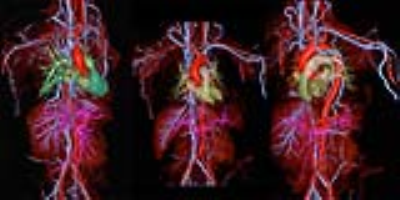Puja Shahrouki1,2, John Moriarty1,2, Biraj Bista1,2, Sarah Khan1,2, Stephen Kee1, Brian DeRubertis3, Takegawa Yoshida1,2, Kim-Lien Nguyen2,4, and J. Paul Finn1,2
1Department of Radiological Sciences, David Geffen School of Medicine at UCLA, Los Angeles, CA, United States, 2Diagnostic Cardiovascular Imaging Laboratory, David Geffen School of Medicine at UCLA, Los Angeles, CA, United States, 3Department of Cardiothoracic Surgery, David Geffen School of Medicine at UCLA, Los Angeles, CA, United States, 4Division of Cardiology, David Geffen School of Medicine at UCLA and VA Greater Los Angeles Healthcare System, Los Angeles, CA, United States
Synopsis
Patients with claustrophobia represent a significant proportion of patients who would otherwise be suitable candidates for MR angiography. With conventional acquisition techniques, examination times for MRA typically exceed 30 minutes and claustrophobic patients are often unwilling or unable to undergo the study. We implemented a new approach to minimize time in the magnet bore for patients with claustrophobia, acquiring comprehensive vascular evaluation of the thorax, abdomen and pelvis in as little as 5 minutes.
Introduction
Whereas MR
angiography has been widely used for more than two decades, the rapid
proliferation of CT angiography has underscored the advantages in speed and
practicality of modern CTA when compared to contrast enhanced MR angiography
(CEMRA). Beyond challenges in workflow,
the relatively long magnet time associated with conventional MR techniques
serves to discourage patients with even modest levels of claustrophobia. Furthermore, recent controversies surrounding
the safety of gadolinium based contrast agents (GBCA) has added further
uncertainty in the cost-benefit balance point of conventional CEMRA. We hypothesize that with the use of
ferumoxytol (Feraheme, AMAG Pharmaceuticals), comprehensive vascular imaging of
the thorax, abdomen and pelvis can be performed in as little as 5 minutes within
the magnet bore, sufficient to reassure all but the most claustrophobic
patients and greatly improving workflow and throughput. Methods
In this HIPAA-compliant and IRB-approved study, all patients expressed reluctance to undergo the MR
examination due to claustrophobia, but agreed to a trial of up to 10 minutes in
the scanner bore. Following localizer sequences, breath held, high-resolution
3-D ferumoxytol enhanced MR angiography (FEMRA) was carried out in one (n=1) or
two (n=12) overlapping stations on a 3.0T MR system (Magnetom
TIM Trio or Magnetom Skyra,
Siemens Medical Solutions) or a 1.5T MRI system (Magnetom TIM Avanto, Siemens
Medical Solutions). Acquisition time for each station was 16-20
seconds and voxel dimensions were on the order of 1 mm x 1.2 mm x 1.3 mm. Overlapping stations were composed into one
large field of view study using vendor software (Image Compose, Siemens). The
total scanning time was measured from the beginning of localizer image acquisition
to the end of the ultimate FEMRA acquisition.
Scanner tuning and coil adjustment routines preceded localizer
acquisition. Patient-specific machine
shimming was not performed and the default shim settings were employed to
minimize adjustment time. Results
Thirteen examinations were carried out in 12 claustrophobic
patients (age 11 to 84 years, 6 females) with renal failure (n=11) or
hemorrhagic hereditary telangiectasia (n=1), who underwent IV infusion of 4 mg
/kg of ferumoxytol (AMAG Pharmaceuticals, Waltham, MA) outside the magnet bore.
All examinations were completed successfully without adverse events. The imaging indications included central
venous occlusion (n=8), aortic stenosis (n=2), central arterial occlusion (n=1),
or hereditary hemorrhagic telangiectasia (n=1). The average scanning time was 6.44
minutes (range 4.16 to 10.10 minutes) including tune up time which was less
than one minute. All scans were
considered of high diagnostic quality and supported full visualization of
arterial and venous anatomy from the neck to the thighs. Conclusion
Comprehensive vascular imaging of the thorax,
abdomen and pelvis can be completed in as little as 5 minutes in the scanner
bore using focused MR angiographic image acquisition, following infusion of
ferumoxytol. The implications for
imaging of claustrophobic patients and for patient throughput are profound.Acknowledgements
No acknowledgement found.References
1.
Dewey M, Schink T,Dewey CF. Claustrophobia during magnetic resonance
imaging: cohort study in over 55,000 patients. J Magn Reson Imaging.
2007;26:1322-7
